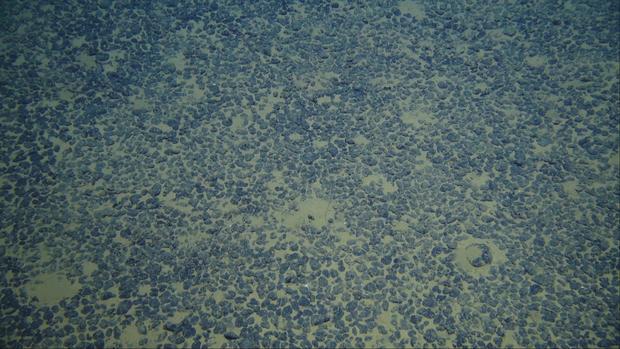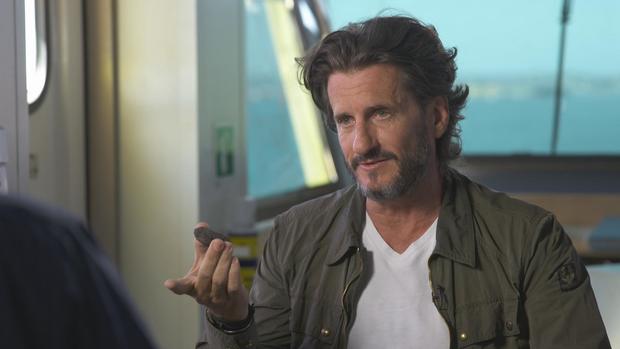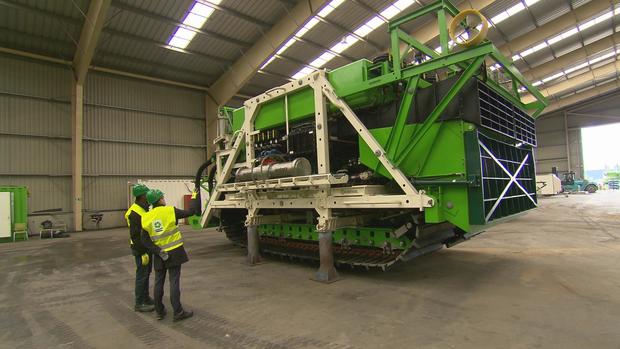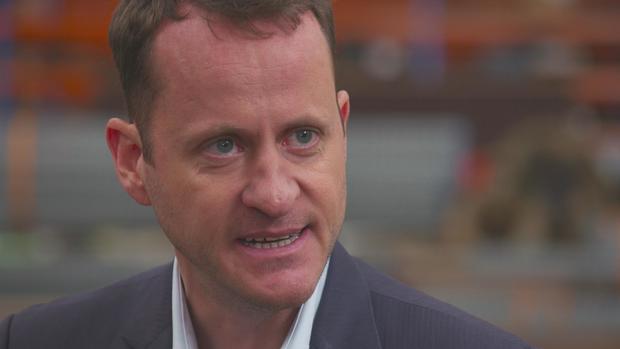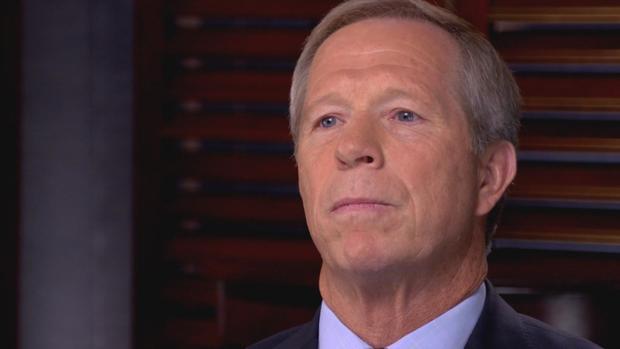Why the U.S. is missing out on the race to mine trillions of dollars worth of metals from the ocean floor
Picture a lump of rock about the size of a potato. Now pack it with some of the most valuable metals on earth, like nickel, cobalt, and other minerals known as rare earth elements. There are trillions of these nodules, that's what they're called, just waiting to be picked up. The problem is they're on the bottom of the Pacific Ocean. The nodules were discovered more than a century ago. Now new technology has triggered a fierce competition to go get them. These metals are critical for modern life: cell phones, electric cars, and supercomputers. Nineteen countries, including China and Russia, have already jumped into the deep. But the one country on the sidelines? The United States. More on that in a moment, but first, we wanted to take a look at this new frontier.
Our adventure began at three in the morning. Loading up our tugboat, we pulled out of San Diego. The harbor lights sank quickly behind us. Ten hours later we were cutting through the chop of the Pacific, with nothing to see but the tossing ocean. So it wasn't hard to spot the Maersk Launcher, a 300-foot mining research vessel, that we'd come to join. All we had to do was get on board. While the launcher dangled a rope ladder above us, the tugboat backed in. With swells over ten feet, timing was everything. At the top of the wave, we took a leap of faith and landed in the new world of deep sea mining.
We were travelling with Gerard Barron, the CEO of Canadian company DeepGreen Metals. He was eager to catch up with the launcher's crew. They'd been at sea for five weeks on a test run, mapping the seafloor, and fishing for nodules. This was the sunken treasure we had come to see.
Bill Whitaker: So what makes them so valuable? What's is in that?
Gerard Barron: Well, that is a electric vehicle battery in a rock.
Bill Whitaker: It looks like a lump of charcoal. (LAUGH)
Gerard Barron: It does. But it's a beautiful lump of-- lump of nodule. The amazing thing is it's filled with nickel and cobalt and copper and manganese. And that's everything we need to build a battery.
To get the nodules, the crew hoists a three-ton rig called a box core over the side. Plunging into the ocean, it begins its three-mile descent to the sea floor. Hours later, it neared the bottom. It felt like watching a new lunar landing.
And there they were. Giant fields of nodules covering an alien landscape. Millions of years old, the nodules grow by absorbing metals from the seawater, expanding slowly around a core of shell, bone or rock. The potential is staggering, estimates of their worth run from $8 to more than $16 trillion.
They are primarily found in the Clarion Clipperton Zone, or CCZ, about 2 million square miles of ocean between Hawaii and Mexico.
On this research trip, DeepGreen scooped up over 100 helpings of the seafloor, each box reeled back on board heavy with the catch of the day: thousands of nodules. In 30 years as a geologist, Warwick Miller told us he'd never seen anything like it.
Warwick Miller: It's a great day to be a geologist.
Bill Whitaker: You said it was a great day to be a geologist, what'd you mean?
Warwick Miller: Ah! We were standing by the box core, I remember holding my hand up. I was covered in mud. Its nice that I get to touch them, you know it's better than looking at them behind in a glass case, for example
Bill Whitaker: They're in all sizes, all different sizes like this?
Warwick Miller: There's different types. The type you're holding there would be type three nodule, which is larger, and it's got a characteristic sort of cauliflower texture to it.
Miller told us each nodule has the same proportion of metals. After they're weighed, and measured, they're stored in a refrigerated container. They will be further analyzed on shore to help DeepGreen figure out where to mine first. They hope to start in three years.
Bill Whitaker: They're that many of them down there?
Warwick Miller: Yeah, exactly. If they found a deposit with this much metal concentration on land, it would be a bonanza that nobody would stop talking about for years.
The rules for deep sea mining are set by an obscure U.N. agency called the International Seabed Authority. It's already divided the CCZ into dozens of concessions. DeepGreen operates two. The company calculates the nickel and cobalt in their patch of ocean alone is enough to make batteries for 150 million electric cars.
Gerard Barron: (LAUGH) I love the fact that they're the way we're gonna get away from fossil fuels. I love the fact that in these, are all the metals we need to go and build those batteries. I mean, it's-- it's-- it's the most amazing coincidence that I've ever encountered Mother Nature made these nodules --
Bill Whitaker: They're just sitting there.
Gerard Barron: It's like, "Okay, you guys, you've messed up planet Earth. Come and get me."
Bill Whitaker: So you call yourself an environmentalist. But you're also a miner. (LAUGH) How do you combine the two?
Gerard Barron: Well, you know, I don't call myself a miner-- but we are collecting nodules off the ocean floor.
Bill Whitaker: So if you're not a miner, what-- what do you call what you will be doing?
Gerard Barron: Well, we call it-- harvesting.
Bill Whitaker: Harvesting.
Gerard Barron: Harvesting nodules from the ocean floor.
Unlike on land, there's no drilling or digging. Instead, enormous deep sea robots will do the heavy lifting. To see one of the most advanced, we travelled to Antwerp, Belgium. In a country better known for beer and chocolate, we met Patania.
Kris Van Nijen: It's a caterpillar. It's a caterpillar track, so we said, "What is the fastest caterpillar on Earth?" And it's called the Patania ruralis.
Kris Van Nijen, the managing director of Global Sea Mineral Resources, or GSR, told us Patania cost $12 million. It's what you might expect if you crossed a bulldozer with a giant vacuum cleaner and then stuffed it with electronics.
Kris Van Nijen: So the nodules are sucked into a stream and they go into the system. It's got the capacity to store three tons of nodules.
Bill Whitaker: Three tons of --
Kris Van Nijen: Three tons of nodules.
Bill Whitaker: How many nodules are down there?
Kris Van Nijen: It is estimated that there is more nickel, more cobalt, and more manganese than on the rest of the planet.
In 2017, GSR was the first to put a robot on the seafloor. Last summer, expectations were high for Patania's second plunge into the Pacific. A specially built frame swung the35-ton machine over the edge of the ship, a fibre optic umbilical cord unspooling as it sank from sight. But then something went wrong, the crew lost the signal to Patania. The test was called off.
Bill Whitaker: Was that-- a big setback?
Kris Van Nijen: A very big setback.
Bill Whitaker: You have said that-- the deep sea has no mercy. Is this what you mean?
Kris Van Nijen: That's exactly what we mean. It has no mercy. It has to be 1,000% perfect or it won't work.
GSR hopes to take Patania back to the Clarion Clipperton Zone soon. When mining begins, Van Nijen told us, the nodules will be pumped to the surface to a waiting ship, before they're processed onshore.
With supplies of some critical metals running low, the race to develop underwater crawlers, like this one led by a Dutch group, is in high gear. But some scientists fear that deep sea mining will wreck the seafloor, a world not fully understood. This rare, albino octopus, nicknamed Casper, a species only discovered three years ago.
Dr. Craig Smith: When we go out and collect a sample on the seafloor, we collect hundreds of new species.
Bill Whitaker: Things that you've never seen before?
Dr. Craig Smith: Sure, oh yeah, yeah.
Craig Smith is an oceanographer at the University of Hawaii. He told us he was surprised at how much life could survive three miles deep. His expeditions to the CCZ have turned up fantastical creatures like this squidworm, or a fluorescent sea cucumber dubbed a "gummy squirrel." There are other deep sea originals too: a foot-long shrimp, a ping pong tree sponge, and a galloping sea urchin.
Bill Whitaker: Mining companies say that the CCZ is only about 1% of the ocean. That the ocean is so vast that-- it could absorb the activity in that--
Dr. Craig Smith: Right…
Bill Whitaker: small portion of--
Dr. Craig Smith: Yeah, that's--
Bill Whitaker: --the ocean.
Dr. Craig Smith: --a little bit like saying the Amazon Rainforest is only 8% of the-- the global land area so we can wipe it out and it doesn't matter.
Bill Whitaker: Won't deep sea mining actually be less invasive, have less of an impact than mining on land?
Dr. Craig Smith: I would say no. Mining is mining. I think it's similar to strip mining on land. And it'll take a really long time for things to recover.
Smith is working with the United Nation's Seabed Authority, which set aside nine protected areas that will be off limits to miners. And Kris Van Nijen has invited independent scientists to monitor GSR's work.
Bill Whitaker: If you find that the environmental impact is severe, would this stop the project?
Kris Van Nijen: Absolutely. I don't think-- we're not in-- into this project to come up with a means to produce metals worse than what is being done today. We're in it because we believe it can be done better.
So far 19 different countries have licenses in the Clarion Clipperton Zone, China has more than anyone else. Russia and Japan have also jumped in. So has France, Germany, Korea, even Cuba and Tonga have stakes. Who's missing? The United States.
It's not for lack of trying. The U.N.'s Law of the Sea covers deep sea mining, and in 1994, President Bill Clinton signed the treaty. But it was dead on arrival in the Senate, despite repeated attempts to ratify it, including this past July.
Bill Whitaker: Is that doing us harm?
Jonathan White: Absolutely. We don't have a seat at that table.
Jonathan White is a retired rear admiral who now runs a non-profit to protect oceans. He told us that being outside the treaty means the U.S. has no say in how this new gold rush is being run.
Jonathan White: It's a law. And if we're not gonna be part of that lawful system, doesn't it make us sort of outlaws of the sea?
With the U.S. on the sidelines, China has poured hundreds of millions into its deep sea ambitions. Last month, China unveiled its new weapons that included an underwater drone that will patrol the ocean.
Jonathan White: If you're in the military, a weapon system, the guidance of our weapons, X-ray machines, microwaves, they all rely on elements that are hard to come by.
Bill Whitaker: So, China controls most of these elements from terrestrial sources?
Jonathan White: Yes.
Bill Whitaker: And now they're going after the lion's share of the seabed sources?
Jonathan White: They certainly are.
Bill Whitaker: Does that concern you?
Jonathan White: It absolutely concerns me. It concerns me with relation to our national security going forward. We need to be in this game.
So we called the 22 senators opposed to the treaty, all Republicans, to ask why. None would appear on camera. Those who wrote us said that ceding any control to the United Nations was a deal-breaker.
But Rear Admiral white worries if the U.S. doesn't ratify the Law of the Sea, it will soon be too late.
Bill Whitaker: And if we don't? What does that mean for us?
Jonathan White: I think it means that, again, we become more isolated, especially in terms of a growing global economy.
Bill Whitaker: And we're dependent on China?
Jonathan White: And absolutely more dependent on China.
Bill Whitaker: So what sense does that make?
Jonathan White: It makes no sense.
The country that made it to the moon first may now miss the race to this new frontier -- and the untold riches of the deep.
Produced by Heather Abbott. Associate producer, Tadd J. Lascari.

